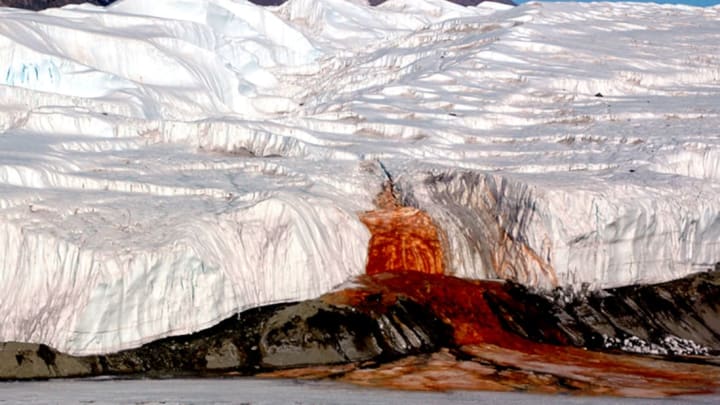In 1911, a geologist on the ultimately doomed Terra Nova expedition to the South Pole discovered a five-story-tall, blood-red waterfall in the middle of the frozen Antarctic desert lands. The area, known as the McMurdo Dry Valleys, is the largest ice-free region on the continent, and one of the coldest, driest, most Mars-like places on Earth.
The so-called Blood Falls ooze from a crack in Taylor Glacier onto the ice-covered Lake Bonney. Twice as salty as seawater, the red brine never freezes. But why is it so red? It's because of the extremely rich presence of iron in the water, which oxidizes and turns crimson when exposed to air, as a research team led by microbiologist Jill Mikucki discovered in 2009. The team also identified 17 microorganisms in the surface brine. Before then, scientists thought a type of algae might be responsible for the red hue.
Image Credit: Peter Rejcek, National Science Foundation
More recent research by Mikucki, published in Nature Communications, discovered that the source of Blood Falls is a subglacial lake. They conducted the first-ever landscape-scale survey of subsurface resistivity in Antarctica. They mapped the region using a large airborne electromagnetic (AEM) system called SkyTEM, which was flown via helicopter. As Smithsonian notes, when water freezes, it has higher electrical resistivity. Salt-rich brine, on the other hand, has low resistivity.
You can see a short video of the AEM system here:
According to New Scientist, the sensor detected a 185-meter-long lake beneath the surface near Blood Falls. Nearly devoid of oxygen and trapped a quarter-mile down for 2 million years, the lake nevertheless harbors life, which appears to use sulfate instead of oxygen for respiration. Because the researchers detected large regions of low electrical resistivity beneath the surface, they believe the lake is one of two extensive subsurface brine systems.
As Mikucki told the Washington Post, "We found, as expected, that there was something sourcing Blood Falls…and we found that these brines were more widespread than previously thought. They appear to connect these surface lakes that appear separated on the ground. That means there's the potential for a much more extensive subsurface ecosystem, which I'm pretty jazzed about."
This is one conceptualization of how the subglacial lakes may connect beneath the surface of the forbidding region:
Image Credit: J.A. Mikuckiin, in Nature Communications
